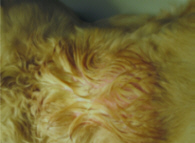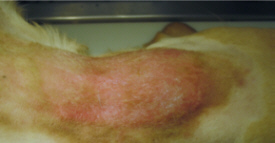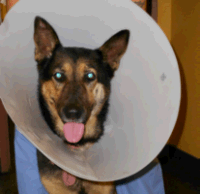|
HOT SPOTS

"HOT SPOTS"
also known as "Pyotraumatic Dermatitis"
|

(Graphic by Dr. Greg Upton.
Used with permission)
|

(Graphic by Dr. Lisa Bennett.
Used with permission)
|

(Graphic by Dr. Lisa Bennett.
Used with permission)
|
|
WHAT IS IT?
When the weather gets warm, one of the things we can count on in our area is seeing more dogs with "hot spots." These wounds are weepy, wet, red and sometimes bloody when they are fresh and they are dry and scabby when they are resolving. They can cover large expanses of the pet's skin or they can appear as smaller solitary lesions (sometimes in multiple locations). Hot spots generally have very clear margins defining them and separating them from normal skin.
They are caused by over-zealous self-licking, chewing, scratching and rubbing (the pet creates them him/herself) and they can arise especially quickly (10 minutes of chewing can create a big one.) The good news is that they almost always look worse than they are. The infection they represent is actually quite superficial and often will resolve with topical treatment alone. The bad news is that about 30% of the pets presented to our hospital for "hot spots" actually have some other kind of skin disease such as deeper skin infection, bite wound or other trauma, or even immune-mediated ulceration. If you aren't entirely sure about what a hot spot looks like, it is probably best to have the vet check the pet.
|

(original graphic by marvistavet.com)
|
WHY DOES THE PET GET SO ITCHY?
The pet causes the hot spot by self-chewing and licking. What causes the pet to self-chew and lick is another story. The pet may have an allergy, may have come in contact with an irritating substance, may have irritation from a grooming clipper, or may have some pain in the area from the underlying tissues. In many cases, the pet simply has fleas and is allergic to their bites. Anything that makes the dog itch will make the dog lick and chew and if the licking and chewing is obsessive enough, a hot spot will soon follow.
|
FIRST AID
Treating a hot spot may or may not be a do-it-yourself project. Smaller hot spots can be treated at home with topical products made for this use. The important thing is to be aware that these areas are tender and the pet may bite if you attempt to put something on the area that stings. Also, be careful about using human topical products as these may be toxic to pets when licked. Zinc oxide, for example, can be toxic when licked and is a common carrier in many human skin ointments.
Initial treatment usually involves removing the surrounding hair so that the hot spot can be disinfected. Once the superficial infection is properly cleansed, topical products can be used to relieve the associated inflammation. The lesion dries and scabs when it is healing. If the pet is very itchy or if there are multiple hot spots, topical treatment becomes impractical and oral or injectable medication becomes necessary. Hot spots just under the ear/on the facial cheek, for example, are notorious for covering up a deeper skin infection below and often require more extensive treatment, especially in the Golden Retriever. More extensive treatments might include oral corticosteroids and/or oral antibiotics in addition to topical antiseptics and anti-inflammatories.
|

(original graphic by marvistavet.com)
|
Good flea control is important for any itchy pet and is the foundation of itch prevention for most dogs and cats. Always be sure you have flea control secured in the approach to managing itchy skin in pets.


Page posted: 10/7/2016
Page last updated: 10/13/2024
|